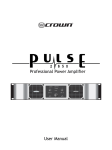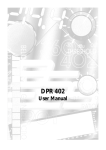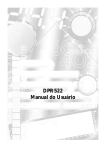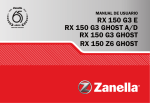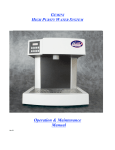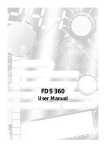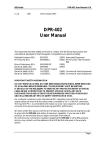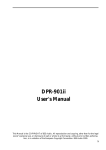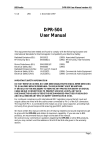Download BSS Audio DPR 422 User manual
Transcript
DPR 422 User Manual 1 V 1.0 JMK 1 April 1997 This equipment has been tested and found to comply with the following European and international Standards for Electromagnetic Compatibility and Electrical Safety: Radiated Emissions (EU): RF Immunity (EU): Mains Disturbance (EU): Electrical Safety (EU): Radiated Emissions (USA): Electrical Safety (USA): Electrical Safety (CAN): EN55013 (1990) Associated Equipment EN50082/1 (1992) RF Immunity, Fast Transients ESD EN61000/3/2 (1995) EN60065 (1993) FCC part 15 Class B UL813/ETL (1996) Commercial Audio Equipment UL813/ETLc (1996) Commercial Audio Equipment IMPORTANT SAFETY INFORMATION DO NOT REMOVE COVERS. NO USER SERVICEABLE PARTS INSIDE, REFER SERVICING TO QUALIFIED SERVICE PERSONNEL. THIS EQUIPMENT MUST BE EARTHED. IT SHOULD NOT BE NECESSARY TO REMOVE ANY PROTECTIVE EARTH OR SIGNAL CABLE SHIELD CONNECTIONS TO PREVENT GROUND LOOPS. ANY SUCH DISCONNECTIONS ARE OUTSIDE THE RECOMMENDED PRACTISE OF BSS AUDIO AND WILL RENDER ANY EMC OR SAFETY CERTIFICATION VOID. For continued compliance with international EMC legislation ensure that all input and output cables are wired with the cable screen connected to Pin 1 of the XLR connectors and/or the jack plug sleeve. The input XLR Pin 1 and the side-chain input jack socket sleeve are connected to the chassis via a low value capacitor, providing high immunity from ground loops whilst ensuring good EMC performance. Please read We have written this manual with the aim of helping installers, sound engineers and musicians alike to get the most out of the DPR-422. We recommend that you read this manual, particularly the section on installation, before attempting to operate the unit. The manual is split into two main sections. The first deals with quick reference information, regarding the functions and operation of the unit, while the second covers a more general background to use and application of the DPR-422. We welcome any comments or questions regarding the DPR-422 or other BSS products, and you may contact us at the address or World Wide Web site given in the warranty section. 2 Contents Contents 1.0 Mechanical installation 5 2.0 Mains Power Connection Mains Power 6 6 3.0 Introduction 7 4.0 Unpacking 7 5.0 5.1 5.2 5.3 5.4 Audio Connections Main Inputs Main Outputs Side Chain Inputs Side Chain Outputs 10 10 10 11 12 6.1 6.2 6.3 6.4 6.5 6.6 6.7 6.8 6.9 6.10 6.11 6.12 6.13 Control Operations Operating Level Threshold Ratio Attack Release AUTO Stereo Link Gain Channel In De-ess Frequency De-ess HF Side Chain Listen 13 13 13 14 15 15 16 16 17 17 18 18 18 19 7.1 7.2 7.3 7.4 Meter displays Input Meter Below Threshold Meter Gain Reduction Meter Output Meter 20 20 20 21 21 2.1 6.0 7.0 3 Contents 8.0 General Applications The need for Gain control Compressors and Limiters The effect of Compression and Limiting on sound De-essing Broadband De-essing HF De-essing 22 22 23 Operation and applications Compression De-essing HF De-essing HF De-essing with full Dynamic control Peak Limiting Side chain insert 26 26 26 27 10.0 Troubleshooting 29 11.0 Warranty Information 30 12.0 Specifications 31 13.0 Glossary 32 Index 34 User Notes 36 8.1 8.2 8.3 8.4 8.5 8.6 9.0 9.1 9.2 9.3 9.4 9.5 9.6 Spare Parts Information 4 24 25 25 25 27 28 28 Mechanical Installation 1.0 Mechanical installation A vertical rack space of 1U (1¾" / 44.5 mm high) is required, with a depth of 190mm. Ventilation gaps are unnecessary (See Figure 1.1). If the unit is likely to undergo extreme vibration through extensive road trucking and touring, it is advisable to support the unit at the rear and/or sides to lessen the stress on the front mounting flange. The necessary support can generally be bought ready-built as a rack tray, or the DPR-422 can be mounted between other units. Damage caused by insufficient support is not covered in the warranty. To prevent damage to the paintwork on the front panel, always use protective plastic cups or washers underneath the rack mounting bolts. As with any low-level signal processing electronics, it is best to avoid mounting the unit next to a strong source of magnetic radiation or heat, such as a high power amplifier. Fig 1.1 Unit dimensions. Fig 1.2 Rack dimensions. 5 Mains Power Connection 2.0 Mains Power Connection 2.1 Mains Power WARNING! THIS APPLIANCE MUST BE EARTHED. The DPR-422 must always be connected to a 3-wire earthed AC outlet. The rack framework must also be connected to the same grounding circuit. The unit must NOT be operated unless the power cables' EARTH (ground) wire is properly terminated - this is important for personal safety as well as for proper control over the system grounding. The wires in the mains lead are colour coded in accordance with the following code. Green and Yellow......Earth Blue......Neutral Brown......Live Those units supplied to the North American market will have an integral moulded 3 pin connector which is provided to satisfy required local standards. IMPORTANT: The DPR-422 is designed to use 50/60Hz AC power in one of the two voltage ranges, selectable with the mains voltage selector switch on the rear of the unit. It is vital that the position of this switch is checked BEFORE initial power up to ensure that it matches the local mains supply. Acceptable input AC supply voltages range from: 115V switch position 230V switch position - 90V to 132V 190V to 265V The application of voltages outside these ranges may cause permanent damage or erratic operation of the unit, and will invalidate the warranty. IMPORTANT: The mains fuse carrier on the rear of the unit must be fitted with the correct type and rating of fuse, depending on the position of the mains voltage selector switch: 115V switch position 230V switch position - T315mA fuse T200mA fuse In the unlikely event of the mains fuse failing without good reason, DISCONNECT THE UNIT FROM THE MAINS SUPPLY, and always replace with the appropriately rated fuse (as specified above) for continued protection against damage and fire. Note: For USA and Canadian users, the replacement fuse must be of an identical UL rated type fuse for continued compliance with safety standards. 6 Introduction Unpacking 3.0 Introduction The BSS DPR-422 compressor, de-esser has been designed in response to the demand for a versatile, cost effective two channel unit which maintains the proprietary, audibly transparent, subtractive VCA technology as used in the well established BSS DPR-402 unit. The provision of a separate, balanced insert input and output per channel minimises the possibility of interference that other units with unbalanced connections may suffer from. To aid the integration of the DPR-422 into the widest range of systems, a rear panel switch allows the operating level of unit to be set to either +4dBu, to suit professional or -10dBV to suit semi-professional equipment. The compressor section allows full control over all the normal parameters, and offers AUTO time constants for general purpose use. The side chain insertion point allows for the patching of external filters to provide dynamic tonal modification for special treatments or special effects. Metering and monitoring is comprehensive and easily interpreted. The full compressor operating range is displayed on a two part meter, indicating both signals below threshold and actual gain reduction. The arrangement of these two meters provides a highly intuitive view of the modification being applied to the input signal. Two modes of de-essing are available on the DPR-422. A dedicated broadband de-esser allows wide band sibilance control simultaneously, and independently from the main compressor. Operation is indicated on two separate LED indicators, and therefore does not compromise the metering for the main compressor. For highly critical de-essing applications, the compressor section can be switched to operate on selected high frequencies only with full control over the ratio, attack and release. The output signal is continuously monitored on the output level meter but depressing the INPUT METER switch allows measurement of the input signal to aid level matching. Provision is also provided for listening to the de-esser filters and any external side-chain equipment to aid accurate setting. 4.0 Unpacking As part of the BSS system of quality control, we check every product carefully before packing to ensure that it reaches you in flawless condition. Before you go any further, please check the unit for any physical damage and retain the shipping carton and all relevant packing materials for use, should the unit need returning. In the event that damage has occurred, please notify your dealer immediately, so that a written claim to cover the damages can be initiated. Check out section 10.0; warranty section, for more info on the warranty, and also to record your dealer details. 7 The DPR-422 Fig 4.1 Front Panel Fig 4.2 Rear Panel 8 All numbers in bubbles refer to Section numbers. 9 Audio Connections 5.0 Audio Connections 5.1 Main Inputs There are 2 input sockets on the rear panel of the 422, Inputs 1 and 2. Each is electronically balanced on standard 3 pin female XLRs at an impedance greater than 10k Ohms. The ‘HOT, + or in phase’ connection is to pin 2 and the ‘COLD, -, or out of phase’ connection is to pin 3. Pin 1 is internally connected to the chassis earth via a low value capacitor. This ensures freedom from ground loops whilst allowing good EMC performance. The screen of the input cable should be connected to pin 1 to ensure that EMC regulations are being met, and the cable shield ground should also be connected to the equipment which is providing the input signal. Fig 5.1 When feeding the DPR-422 from unbalanced sources, connect the signal conductor to pin 2 and the cable screen to pins 1 and 3. Transformer isolated inputs are available as a dealer fitted option. Fig 5.2 5.2 Main Outputs Fig 5.3 10 The output signals are electronically balanced and fully floating on 3 pin male XLRs. Full headroom is available into any load of 600 Ohms or greater. The signal ‘HOT, +, or in phase’ signal is to pin 2, the ‘COLD, -, or out of phase’ signal is to pin 3, with pin 1 being connected directly to the chassis. When using the DPR-422 to drive unbalanced inputs, best performance is usually obtained by connecting the DPR-422s ‘+’ signal to the equipment signal pin and the ‘-’ signal to the equipment shield. Fig 5.4 The DPR-422 shield should normally be connected to the equipment shield, preferably at the equipment end. Transformer isolated outputs are also available as a dealer fitted option. 5.3 Side Chain Inputs The side chain insert inputs are electronically balanced via stereo 5mm jack sockets at an impedance greater than 100k Ohms. The ‘HOT, +, or in phase’ connection is to the jack plug tip, the ‘COLD, - or out of phase’ connection to the ring. The shield is internally connected to the chassis earth via a low value capacitor. This ensures freedom from ground loops whilst allowing good EMC performance. The screen of the cable must be connected to the jack plug shield to ensure continued compliance with EMC regulations. The cable shield ground should be connected to the equipment which is providing the input signal. Fig 5.5 When feeding the DPR-422 from unbalanced sources, connect the signal conductor to the jack plug tip and the cable screen to the plug ring and shield. Fig 5.6 11 Audio Connections 5.4 Side Chain Outputs The side chain uses a quasi-balanced ‘ground compensated’ output. When connected to a balanced input, interference rejection equivalent to a fully floating output can be obtained. Full headroom is available into any load of 2k Ohms or greater. The signal ‘HOT, +, or in phase’ signal is to the jack plug tip. The ‘COLD, -, or out of phase’ signal is to the ring with the shield being connected directly to the chassis. Fig 5.7 Connection to unbalanced inputs may be done by connecting the tip to the signal input and the ring to the input shield. The DPR-422 shield may or may not be connected to the equipment shield at the equipment end. Fig 5.8 12 Control Operations 6.0 Control Operations 6.1 Operating Level Setting this switch on the rear panel to +4dBu configures the DPR-422 for connection in a professional system. The THRESHOLD control and OUTPUT METER will read in dB relative to 0dBu, and the side chain insert points will be set for connection to professional signal level equipment. With the switch set to -10dBV, the DPR-422 shifts its internal operating point to make it more suitable for connection to semi-professional equipment. The internal gain structure of the unit is also optimised for these lower overall signal levels. The insert points will also be shifted to match that of the main signal path. Note that in either position of the switch the DPR-422 has an overall gain of unity (with the GAIN control set to 0dB). The insert points also have unity gain relative to the main signal path in either mode and, of course, the operation of the DPR-422 is the same in either mode. 6.2 Threshold Gain reduction in the DPR-422 is achieved using a Voltage Controlled Attenuator (VCA) with a range or operational ‘window’ of approximately 35dB. This means that it is capable of reducing the input signal by up to 35dB or nearly 60 times. The GAIN REDUCTION METER displays this window, showing how much attenuation is being used. The signal level corresponding to the lower boundary of this window is called the THRESHOLD, and input signals below this level do not cause gain reduction. When the input level exceeds the threshold, the gain reduction will kick in. The amount of gain reduction or ‘compression’ produced is directly proportional to the amount by which the input signal level exceeds the threshold. The maximum gain reduction available is set by the circuitry at a level 35dB above the threshold. The THRESHOLD control adjusts the threshold relative to the input signal in order to set the compressor to the required amount of gain reduction. For example, if the average input is +12dBu and the THRESHOLD control is set to -10dBu, then the top 22dB, [12-(-10)]=22dB, of the signal can be compressed. The THRESHOLD control is adjustable from -30dBu to over +20dBu. 13 Control Operations When the THRESHOLD control is set fully clockwise to the position marked OUT the threshold can not be reached, regardless of the input level, and the signal will always reach the output uncompressed. How the compressor performs on signals above the threshold is controlled by the RATIO, ATTACK, and RELEASE controls (see the following sections for more info.) 6.3 Ratio The effect of the ratio control can be shown on a graph which plots input level against output level (see figure 6.1). This clearly shows that below threshold the DPR-422 acts purely as a linear amplifier. Fig 6.1 Effect of ratio In applications where gentle compression is required, it is beneficial to change from the linear to compression region in a very gradual manner, rather than the more conventional abrupt manner as shown above. The DPR-422 has been configured so that for low settings of the ratio control and low levels of compression, the transfer is soft, and for increasing ratio settings and high levels of compression the transfer becomes harder. This ‘progressive knee’ gives inaudible compression for low levels of ratio and gain reduction, whilst allowing harder compression for effective limiting and extreme control when required. This feature is exclusive to BSS equipement, and is why the DPR-422 doesn't require a 'soft knee' control as all other compressors do. 14 6.4 Attack This control determines how quickly the DPR-422 compressor responds to signals once the threshold is exceeded and provides a range of times from 50us to 100ms. For transient signals (very sudden 'spikes' in the signal that last a short time), a fast attack time is desirable. For other types of program material a slower time will be more useful. It is always better to start with a slower time, and progressively speed up the response as necessary, since too fast a time may cause distortion of the sound, especially with signals that contain a lot of low frequencies. The times printed around the control refer to the approximate time taken for the signal to be reduced by two thirds of the ultimate reduction. 6.5 Release Release determines how quickly the compressor returns to normal gain following a transient over the threshold. The setting of the release time can be varied from 5ms to 2s, and is very much dependant on program type. The times printed around the control refer to the approximate time taken for the signal to be recovered to 90% of from the initial level. The setting of a wrong speed will result in one of the following conditions: 15 Control Operations If set too fast, the overall volume level will jump up and down, exactly following the peaks above threshold, producing an unpleasant effect. If set too low, quiet parts of the program immediately following loud transients will be subjected to ‘breathing’ or ‘pumping’ effects caused by the VCA releasing its attenuation (or effectively increasing the system gain) during the quiet program period, when it is not required. 6.6 AUTO This feature of the DPR-422 is provided to overcome some of the conflicting setting requirements associated with the attack and release controls. It is accessed by pressing the AUTO button, whereupon the DPR-422 automatically adjusts itself to provide the required attack and release time settings, dependant on the program content. AUTO uses a combined program related attack time setting and a two part program related release time setting. The two part program dependant release provides a fast release to restore below threshold gain as soon as the transient has passed, and a much longer following release to avoid rapid gain change effects. Note that once AUTO has been selected, the attack and release controls become inoperative. 6.7 Stereo Link Depressing this button enables the two channels of the DPR-422 to be used in a stereo system, and ensures that there will be no stereo image shifting under compression or de-essing. The STEREO LINK switch couples the detector outputs from both channel 1 and channel 2 together, so that both channels respond equally to the largest signal present. This combined signal is passed through the THRESHOLD, RATIO, ATTACK, RELEASE and AUTO controls of channel 1 and is then applied to BOTH the channel 1 and channel 2 VCAs. Independent operation of the channel GAIN controls is maintained in link mode, and they must BOTH be set appropriately. 16 When linked, the channel 1 below threshold meter shows the combined channel 1 & 2 signal. The channel 2 below threshold meter shows only signals on channel 2, this provides a visual indication that there is a signal on channel 2. Note that the level on the channel 2 meter can be changed with the channel 2 threshold control, although along with the channel 2 de-ess, ratio, attack, release and auto controls, this has no effect on the operation of the unit. If desired, the channel 2 threshold control can be set to OUT and there will then be no signal on the channel 2 below threshold meter. The gain reduction meters for both channels indicate the same value, as controlled from channel 1. The output meters indicate the level on their respective channel. If the DPR-422 is being used in either broadband or DE-ESS HF mode, it is important that the FREQUENCY control for both channels are in the same position. 6.8 Gain As compression is a gain reducing process, the output signal level will often be less than the input. The GAIN control is provided to restore the output signal to the desired operating point, and provides a calibrated range of ±20dB relative to the input signal. The facility for gain loss provided by this control can be used, when required, to restore the compressed signal to a point lower than the input signal and might be useful, for example, when connecting the output to a high sensitivity input on a following piece of equipment. 6.9 Channel In When the CHANNEL IN switch is in the out, non illuminated position, all DPR422 functions are bypassed and the input is connected directly to the output via a relay. This condition also occurs when the power is off, and ensures that the signal is passed through the unit in the case of a power or fuse failure. When the switch is pressed in, the processed signal is passed to the output. In bypass mode, the input is still connected to all of the DPR-422 circuitry, so that all of the required facilities can be selected and set up. This, in conjunction with the OUTPUT METER and INPUT METER SWITCH, provides a powerful tool for comparing processed signals prior to operating the bypass switch and going ‘live’. 17 Control Operations 6.10 De-ess The DE-ESS control determines how much gain reduction the BROADBAND de-esser applies to the signal when a sibilant sound is detected. The maximum amount of gain reduction available in this mode is approximately 20dB. The dynamic settings for the broadband de-esser are set automatically by the DPR422 and are optimised for general vocal work. The green and yellow LEDs above the de-ess control provide a simple indication of the degree of de-essing, with the green LED indicating the start of the operation, and the yellow LED indicating approximately 15dB of gain reduction. In association with the FREQUENCY control the broadband de-esser provides a very simple and effective way of treating general sibilant vocal signals, when processed on their own. 6.11 Frequency The FREQUENCY control should be set to coincide with the lowest frequency in the sibilance sound. To aid the setting of the frequency control, the SIDE CHAIN LISTEN switch can be depressed and the onset of the lowest sibilant frequency at the output of the selection filter can then be heard. Note that this will only be the case if the de-ess HF mode is engaged. If the filter is being setup for use by the broadband de-esser, temporarily engage de-ess HF mode to enable SIDE CHAIN LISTEN to pass the filter signal. 6.12 De-ess HF Depressing this button causes the main compressor to be used as a high quality high frequency (HF) de-esser. As in broadband de-essing, the compressor is still only activated when frequencies above the setting of the FREQUENCY control are encountered. However, once activated, the DPR-422 will only reduce (compress) those signals that caused the activation. In other words, the DPR422 behaves rather like a program dependant high frequency filter. To allow fine control of the de-essing, the main compressor THRESHOLD, RATIO, ATTACK, RELEASE and AUTO controls, in addition to the FREQUENCY control 18 are used. The setting of these controls should broadly follow the directions given in the respective parts of this manual. The below threshold and gain reduction meters are used to monitor the operation of the HF de-esser. The DEESS control, active and high LED’s play no part in HF DE-ESS mode and are automatically disabled when the DE-ESS HF mode is activated. Depressing the SIDE CHAIN LISTEN switch allows the operation of the FREQUENCY control to be monitored, allowing it to be optimally set to reduce the level of sibilant frequencies whilst removing as little other program material as possible. If general compression is required simultaneously with HF de-essing, then channel 2 of the unit can be used by connecting the two channels in series with an external cable. 6.13 Side Chain Listen If the DPR-422 is in compress mode (de-ess HF switch out), depressing this switch will switch the output of the unit from the compressor output to the return signal from the control side chain insertion point. This will allow monitoring of any external equipment which is connected to the unit to assist in its setting up. With the de-ess HF switch in, the side chain listen switch connects the output of the de-esser filter to the output to allow accurate setting up of the FREQUENCY control by listening to the actual sibilant sounds. It is recommended that the de-ess HF switch is temporarily depressed to allow the output of the de-ess filter to be monitored to aid the setting of the FREQUENCY control for use by the broadband de-esser. Once setup, the deess HF switch can be returned to the desired position. 19 Metering displays 7.0 Meter displays 7.1 Input Meter The INPUT METER switch is used in conjunction with the OUTPUT LEVEL meter to allow the input signal to be displayed. The switch has a momentary action to ensure that the meter is not inadvertently left showing input level. This facility becomes extremely useful when used in conjunction with the CHANNEL IN switch. During initial setting up with the DPR-422 in BYPASS mode, the meter input switch will enable the input and output levels to be compared on the same display, enabling adjustments to be made with the GAIN control to ensure that the input and output levels are similar (the GAIN control will only affect the output signal level). Once satisfied that the levels are matched, operation of the CHANNEL IN switch will ensure an unnoticeable ‘drop-in’. 7.2 Below Threshold Meter The five LEDs of the BELOW THRESHOLD meter give an indication of where the input signal is in relation to the start of compression. The LED marked ‘TH’ is halfway on all the time and this point represents the threshold point as set by the THRESHOLD control, any signal that exceeds this level will start the compressor operating. Observation of this meter during operation will give an instant picture of how close the signal peaks are to being processed. This is especially useful for live concert work as signal levels tend to increase during the course of the show. 20 7.3 Gain Reduction Meter Once the input signal has exceeded the threshold point on scale, the compressor starts to operate, and gain reduction will occur. The amount of gain reduction being used is displayed on the GAIN REDUCTION meter. Gain reduction is a useful way of expressing compressor action as it gives an instantaneous indication of how much the signal is actually being processed. If, for example, a particular signal transient exceeds the threshold point by 12dB and the ratio knob is set to 2:1, then we would expect the output to have only increased by 6dB (providing the attack and release controls are set accordingly). Assuming the gain control is at 0dB, the difference between the input and output levels of 6dB then represent the amount of gain reduction which has occurred and will be displayed on the gain reduction meter as 6dB. The range of the gain reduction meter is set to display the first 24dB of the 35dB VCA operating window. 7.4 Output Meter This meter monitors the signal level at the output of the DPR-422, and gives you an absolute reading of its level. If the rear panel OPERATING LEVEL is in the +4dBu position, the meter will read accurately in dBu. If the switch is set to -10dBV, the meter will read in dB relative to -14dBV. 21 General applications 8.0 General Applications 8.1 The need for Gain control The human ear excels in its ability to detect an extremely wide range of sound levels. These can range from the quietest whisper to the roar of a jet aircraft. When we attempt to reproduce this large range (dynamic range) of sounds with amplifiers, tape recorders or radio transmitters, we run into one of the fundamental limitations of electronic or acoustic equipment - a restricted usable dynamic range (although in some cases, such as amplifiers, the dynamic range available is quite good). Fig 8.1 Dynamic Range What limits the available dynamic range of this equipment is its inherent noise floor at the bottom end, and the maximum input signal resulting in an acceptable amount of distortion at the upper end. The usable dynamic range sits in between these two limits, and it is common practice to operate a piece of equipment at a level that is somewhat below the upper distortion point, leaving a margin of safety for the unexpected transient loudness peaks present in program material. The safety margin is known as headroom, and is generally in the range of 10 to 20dB. Lowering the standard operating level to increase headroom helps reduce the likelyhood of distortion, but moves the average program level nearer to the noise floor, thereby compromising the signal to noise performance. It therefore becomes apparent that to get the most out of an audio system, the standard operating level must be kept as high as possible without risking distortion. 22 Fig 8.2 Operating level and headroom One solution to this problem is for the operator of the equipment to be continuously monitoring the program, and manually adjusting the gain to suit the moment. When the program is quiet, the gain can be increased, and when the program is loud the gain can be reduced. However, in most types of program there are instantaneous short duration level peaks or transients, which would be difficult to anticipate and impossible to respond to in the required time. Even a sound engineer with the quickest reflexes could not bring gain knob or fader down quickly enough. The need therefore arises for a fast acting automatic gain controlling device which will track the program material constantly, and which will always adjust the gain to maximise the signal to noise performance without incurring distortion. This device is called a compressor or limiter, and is one part of the DPR-422 8.2 Compressors and Limiters Compressors and limiters have closely related effects, and in general a limiter will reduce gain very strongly once a certain level has been reached, whereas a compressor will act gently, but over a much wider range of volume levels. A limiter will continuously monitor program levels, but only commence to reduce gain once the level has exceeded a preset amount. This point is called the threshold level. Any program level in excess of the threshold will immediately be reduced to this threshold level. A compressor will also continuously monitor the program and has a threshold level. However, program signals in excess of this threshold will be progressively reduced by an amount (ratio) depending on the degree to which it initially exceeds the threshold. Generally, threshold levels for compressors are set below the normal operating level to allow them to reduce the dynamic range of the signal gradually, so that they are acceptable to following equipment. For limiters, the threshold point will be set above the operating level in order to provide a maximum level for signals to following equipment. 23 General applications 8.3 The effect of compression & limiting on sound Consider an input signal which is applied to two units, one having its threshold point set 10dB higher than the other. Since the compressor only affects signals that exceed the threshold level, the signal with the lower threshold applied will be more affected than the other. Referring to figures 8.4a & b, assuming that all Fig 8.3a High threshold level Fig 8.3b Lower threshold level other controls on both channels are set identically with gains equalised, it is immediately apparent that the signal processed with the higher ratio is said to have been limited, whereas the signal with the lower ratio is said to have been compressed. Fig 8.4a Effect of compression with high ratio Fig 8.4b Effect of compression with lower ratio 24 Comparing the input and output waveforms for the compressed mode, the loudest portions of the signal have been effectively decreased in level, and if the gain control is adjusted to compensate for this, the quieter portions will be increased. The net effect, therefore, is for both ends of the dynamic spectrum to be pushed (or squeezed) towards each other. This squeezing effect of compression is important to remember, and provides a major difference between compression and limiting. I.e. Limiters do not make-up the gain reduction. The range provided by the DPR 422 on its ratio and release controls is sufficient to allow its use either as a compressor or limiter. For limiter applications, the release fast switch should generally be out. 8.4 De-essing A common problem encountered when amplifying the human voice is the large amount of High Frequency energy, heard as the sibilant ‘sss’ sound. These high frequency or sibilant sounds can reach levels considerably greater than the normal voice level, and will result in signal break-up or distortion. It is possible to control these sounds independently of the normal program by making a normal compressor sensitive only to these high frequencies. Selective high frequency compression is generally called de- essing, as it removes the ‘sss’ content from the program. The DPR-422 can provides this capability in either of two distinct ways, BROADBAND de- essing and HF DE-ESSING. 8.5 Broadband De-essing As set by the DE-ESS control with the DE-ESS HF switch OUT, once the DPR422 detects excessive amounts of signal above the frequency set by the FREQUENCY control, it will start to gain reduce the program level. As this reduction occurs over the whole frequency range of the program, it is called broadband de-essing. Remember though that no reduction occurs unless the DPR-422 encounters a high frequency signal, and that in broadband mode, the main compressor is not utilised and remains available. 8.6 HF De-essing Selected by depressing the DE-ESS HF button, this provides an extension to broadband de-essing by only compressing signals with a frequency above that set by the FREQUENCY control. Signals with frequencies below that set by the FREQUENCY control are unaltered. HF DE-ESS mode may be considered to function rather like a dynamic HF filter. The type of de-essing to be used in a particular situation will depend largely on the program type, and whether the input to the DPR-422 is a mix of sibilant sounds and other program material, or exclusively the sibilant sound, for example a vocalist. HF only de-essing will generally be used when processing a mix of program, whereas broadband de-essing will be acceptable when processing only the sibilant sound. It should be realised that de-essing is very different from simple equalisation, since equalising a sibilant vocal by cutting high frequencies would result in loss of high frequency content at all times. De-essing has no effect whatsoever on the signal, except at the moment of sibilance, and then the effect is only of overall level change. There is no change in the general frequency response, yet sibilance is controlled. 25 Operations and applications 9.0 Operation and applications 9.1 Compression Rotate the THRESHOLD control anticlockwise until the BELOW THRESHOLD meter is fully illuminated and an appropriate amount of gain is indicated on the GAIN REDUCTION meter. This operation will be accompanied with a drop in output level, as indicated by the OUTPUT METER. The output GAIN CONTROL should now be adjusted to reinstate the output level. The levels of the uncompressed input signal and the compressed output signal can now be compared on the output meter by operating the METER INPUT switch. Final adjustments of the controls can then be made to suit particular requirements, including the RATIO, ATTACK, and RELEASE controls. The AUTO switch provides for a program related operation of the dynamics of the unit, and will be acceptable for most general purpose applications. Should a tighter or looser requirement be necessary, then both the attack and release controls can be set individually to suit. Note that with AUTO engaged, the ATTACK an RELEASE controls are inactivated. The experienced engineer will be able to set the compressor controls to near optimum position for any source material with the CHANNEL switch out, so that the compressor can be ‘dropped’ into a live performance without disturbance. 9.2 De-essing The DPR-422 has two modes of de-essing available, BROADBAND de-ess with simultaneous compression, and DE-ESS HF with full dynamic control. De-ess wide attenuates the whole frequency spectrum, and although acceptable for most vocal sources, it may cause undesirable side effects on a mixed program source. HF DE-ESS only attenuates the high frequencies and therefore produces superior results in all cases, which is essential when de-essing a mixed program source. If simultaneous de-ess HF and compression are required the separate channels must be used, one for each function. Broadband De-essing Gradually rotate the DE-ESS control anticlockwise until the required effect is achieved. The FREQUENCY control can also be adjusted to ensure that frequencies lower than those causing concern do not initiate de-essing. It should be remembered that this de-essing is wideband and may cause distortion or pumping effects if the source program contains significant low frequencies. 26 HF De-essing with full Dynamic control Rotate the THRESHOLD control anticlockwise until the BELOW THRESHOLD meter is fully illuminated and an appropriate amount of gain reduction is indicated on the GAIN REDUCTION meter. The FREQ control and THRESHOLD control can now be fine tuned to achieve the desired effect whilst listening to the program. Gain compensation will not normally be required when de-essing. Although fast attack and release times are most appropriate, they should be adjusted to achieve the best results. The AUTO switch should NOT be depressed. To aid the correct setting of the FREQ control in relation to the audible sibilance, the source program can be listened to by depressing the SIDE CHAIN LISTEN switch. This replaces the normal signal at the output connector with the output of the de-ess filter. 9.3 Peak Limiting Apply a signal to the DPR-422 input that is at the maximum level required without limiting. Rotate the THRESHOLD control anticlockwise until the peaks of the normal program cause the gain reduction meter to indicate compressor operation, then rotate the THRESHOLD control back slightly so that no operation is indicated. Peaks in the program that exceed the norm will now be hard limited as the RATIO control is set to infinite. The GAIN control should be set so that the (limited) output of the DPR-422 matches that expected by following equipment. Note that the setting of the ATTACK and RELEASE controls represent a compromise between speed of limiting and audible side effects. For effective limiting, the ATTACK should be set fast. 9.6 Side chain insert A very common requirement is to make the threshold of the compressor frequency conscious by inserting a graphic or parametric equaliser into the control side chain. The input of the external equipment should be connected to one of the send outputs of the unit, and the output of the external equipment connected to one of the return inputs, as required. All of the external equipment should be capable of operating at the general line levels set by the rear panel OPERATING LEVEL switch have unity gain, an input impedance greater that 10k Ohms and an output impedance less that 1k Ohms. In order to preserve the THRESHOLD control calibration, it is essential that unwanted frequencies are attenuated rather than wanted frequencies boosted by the external filter. For example, if compression is to be controlled by a narrow mid-band of frequencies, then the low frequency and high frequency sliders should be pulled down, and the mid-band sliders left at 0dB. 27 Troubleshooting 10.0 Troubleshooting Problem: No output. Solution: Is the Mains Power connected? Check the connections. See fuse failure (below). Do you have an input signal? Check the Input and Output connections. Are the power amplifiers switched on? Problem: Fuse failure. Solution: The mains supply fuse is unlikely to blow without an electronic fault being present. If the CORRECT replacement fuse blows again at switch on or after a short interval, switch off the unit and arrange for servicing. 28 Warranty Info 11.0 Warranty Information When sold to an end user by BSS Audio or a BSS Audio Authorised Reseller, this unit is warranted by the seller to the purchaser against defects in workmanship and the materials used in its manufacture for a period of one year from the date of sale. Faults arising from misuse, unauthorised modifications or accidents are not covered under this warranty. No other warranty is expressed or implied. If the unit is faulty it should be sent to the seller of the equipment, in its original packaging with shipping prepaid. The unit will be returned to you when the repair has been completed. If the unit was purchased in the European Union, you may, as an alternative, return the unit to any other BSS distributor in the European Union. You should include a statement listing the faults found. The unit’s serial number must be quoted in all correspondence relating to a claim. IMPORTANT We recommend that you record your purchase information here for future reference. Dealer Name: Dealer Address: Post/Zip Code: Dealer Phone No.: Dealer Contact Name: Invoice/Receipt No.: Date of Purchase: Unit Serial Number: In keeping with our policy of continued improvement, BSS Audio reserves the right to alter specifications without prior notice. The DPR-422 was designed and developed by BSS Audio, Hertfordshire, England. Phone (+44) (0)1707 660667. Fax (+44) (0)1707 660755. World Wide Web address: http://www.bss.co.uk 29 Specifications 12.0 Specifications General Input Impedance Input Headroom Input CMRR Output level Output Impedance Output Gain Frequency Response Noise Dynamic Range Cross Talk Distortion 10k ohm balanced or unbalanced >+20dBu >-50dB (30Hz-20kHz) >+20dBu into 600 ohms or greater <50 ohms unbalanced or unbalanced +/-20dB continuously variable 10Hz-80kHz (+/-3dB) -96dBu (22Hz to 22kHz) >117dB >-85dB (20Hz to 20kHz) <0.005%THD (80kHz measurement BW) 20Hz-20kHz. Typically 0.002% at 1kHz, Unity Gain +10dBm output below threshold Compressor Threshold range Compressor ratio Maximum VCA range Distortion -30dB to 20dB continuously variable 1:1 to infinity:1 continuously variable >30dB Typically <0.05%THD (80kHz measurement BW) @ 2kHz 0dBu out with 6dB gain reduction, AUTO engaged Attack Time 50us-100ms continuously variable Release Time 5ms-2S continuously variable AUTO TIME constant Three part program dependant time constant with Attack time typically 200us, Release 10ms De-esser Threshold range -30dB to 20dB continuously variable Ratio Infinite, at and above twice the set frequency Frequency Range 1kHz-10kHz continuously variable Note: With the compressor active, THD will increase with reduced frequency and shorter time constants, which is inherent in this type of equipment. 30 Glossary 13.0 Glossary Active Active electronic circuits are those which are capable of voltage and power gain by using transistors and integrated circuits. Amplitude Refers to the voltage level or intensity of a signal, and is usually measured in voltage or decibels. Attack Time The amount of time taken for the compressor or limiter to kick in and start gain reduction once the input signal has exceeded the threshold level. This is usually measured in micro or milliseconds (millionths or thousandths of a second). Balanced A three wire connection in which two of the wires carry the signal information, and the third acts as a shield tied to chassis ground. The two signal lines are of opposite polarity (out of phase by 180 degrees) at any given moment in time, and are of equal potential with respect to ground. Balanced connections are used to reduce hum and noise in system interconnections. Breathing Compressor dB A term used to describe the fluctuations of background noise resulting from the compressor action. An electronic circuit which reduces its input to output gain as the input signal increases above a predetermined threshold level. A unit for expressing the ratio between two signal levels for comparison purposes. On its own it has no absolute level meaning. Rather, it is a logarithmic ratio used to express the differences between two amounts or levels. Positive numbers indicate an increase, and negative ones a decrease. Some useful ratios are: +3dB +6dB +10dB +20dB dBm = = Double Power x 2 Voltage or x 4 Power = x 3 Voltage or x 10 Power = x 10 Voltage or x 100 Power The addition of ‘m’ after dB indicates an absolute scaling for the dB ratio. Instead of a ratio, the dB becomes a measure of voltage. 0dBm = a power level of 1 milliwatt into a load of 600 ohms. It is also loosely used to describe signal voltage in 600 ohm circuits. dBu or dBv The addition of ‘u’ or ‘v’ after dB indicates an absolute scaling for the dB ratio. 0dBu (or 0 dBv) = 778mV or 0.778 Volts, and it has no regard for power or impedance. This term is widely used for expressing signal voltages in modern audio equipment with high input impedances and low output impedances. dBV Distortion The same scale as for dBu as above, except that 0dBV = 1.0 Volts. Any modification of a signal which produces new frequency components not 31 Glossary presents in the original. Harmonic distortion refers to added frequencies that are overtones to the fundamental frequency. Intermodulation distortion refers to added frequencies that are sum and difference values derived from the beating together of two frequencies. Drop-in A term used to describe the way in which new equipment, or a hitherto unused function of equipment already connected, can be switched into a live sound system without causing unwanted effects, i.e: without causing clicks or a noticable change in sound level. Equalisation Modification of the frequency response of an audio system, regardless of level, for corrective or enhancement purposes. Frequency Frequency Response The equipment’s relative gain compared to frequency. Generally expressed as +/- a certain number of dBs from 20Hz to 20kHz. Gain reduction The amount, in dBs, by which a compressor/limiters output has been reduced in level with respect to its uncompressed level. Headroom The amount, in dBs, above the normal operating level that can be used before serious distortion commences. Impedance The AC equivalent of resistance and measured in ohms. It indicates the amount of drive required for an input, or the drive capability of an output, at a given signal level. Level Line Level The amplitude of a signal, measured in Volts or Decibels. Generally indicates a signal whose level is between -10 and +10dBu or -14 to +6 dBV. Mic level refers to levels around -40dBu. Limiter Similar to a compressor but harder acting, and generally used as a protection device for audio systems. Octave A logarithmic unit for expressing frequency ratios. Positive values indicate an increase and negative ones a decrease. One octave ‘up’ the scale is equivalent to double the frequency. One octave ‘down’ is equivalent to half the frequency. Ratio The relationship between change in input level and resulting change in output as a consequence of compressing or limiting. Release Time The time required for a compressor or limiter to restore its gain to normal, after the input signal has fallen below threshold. Sibilance Threshold 32 The repetition of a waveform. The unit of frequency is Hz, and 1 cycle per second is equal to 1Hz. The audio band is generally restricted to frequencies of 20Hz to 20,000Hz (20kHz). The distortion caused by large high frequency signals superimposed onto a normal signal, such as the ‘sss’ sounds of human voice. The pre-settable level above which a compressor or limiter will commence to gain reduce. Transient Unity Gain A sudden burst of energy in an audio signal which only lasts for a small period of time relative to the rest of the signal. The level of these transients can often reach 10 times (+20dB) or so above the normal operating level of the audio equipment, and may cause distortion of headroom is inadequate. Where output level is equal to input signal level. 33 Index Index A Attack Audio connections Inputs Outputs Side Chain Inputs Side Chain Outputs AUTO 15 10 10 11 12 16 B Breathing 16 17 23 26 24 15 16 17 18 18 18 17 13 14 15 19 16 13 D De-ess De-ess HF De-essing application Broadband HF Dimensions Dynamic range 18 18 25 26 25 25 5 22 6 F Frequency 34 Gain Gain control Glossary 17 22 31 I 5 L Limiters effects of 23 24 M Mechanical installation Meters Below Threshold Gain Reduction Input Output 5 20 21 20 21 O Operating Level 13 P Peak Limiting application Power connection Power requirements Pumping 27 6 6 16 R Rack space Ratio Rear Panel Release 5 14 8 15 S E Earthing 8 6 G Installation C Channel In Compression application effect of Controls Attack AUTO Channel In De-ess De-ess HF Frequency Gain Operating level Ratio Release Side Chain Listen Stereo Link Threshold Front Panel Fuse rating 18 Side chain insert application Side Chain Listen Specifications Stereo Link 27 19 30 16 T Threshold Troubleshooting 13 28 U Unpacking 7 V Voltage Controlled Attenuator Voltage selection 13 6 W Warranty 29 35 User Notes 36 37 User Notes 38 39 User Notes 40










































